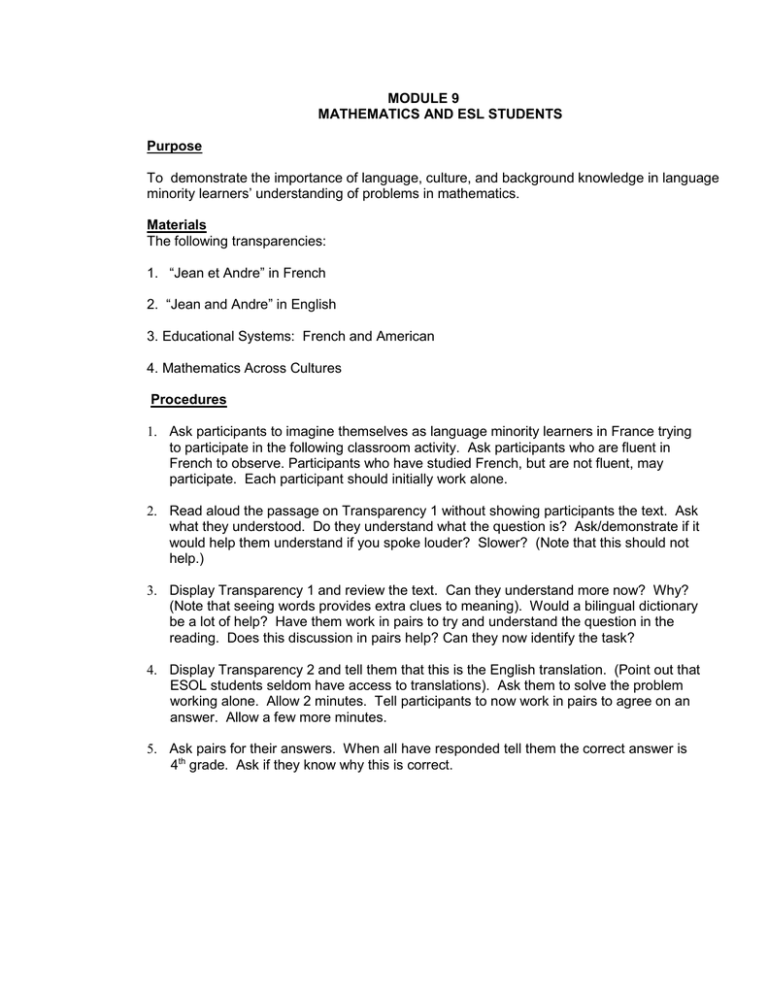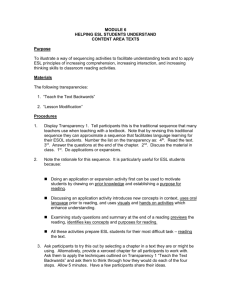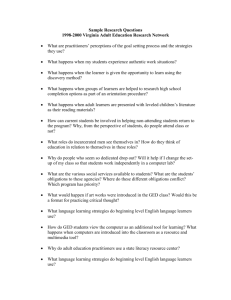Module 9 Mathematics and ESL Students
advertisement

MODULE 9 MATHEMATICS AND ESL STUDENTS Purpose To demonstrate the importance of language, culture, and background knowledge in language minority learners’ understanding of problems in mathematics. Materials The following transparencies: 1. “Jean et Andre” in French 2. “Jean and Andre” in English 3. Educational Systems: French and American 4. Mathematics Across Cultures Procedures 1. Ask participants to imagine themselves as language minority learners in France trying to participate in the following classroom activity. Ask participants who are fluent in French to observe. Participants who have studied French, but are not fluent, may participate. Each participant should initially work alone. 2. Read aloud the passage on Transparency 1 without showing participants the text. Ask what they understood. Do they understand what the question is? Ask/demonstrate if it would help them understand if you spoke louder? Slower? (Note that this should not help.) 3. Display Transparency 1 and review the text. Can they understand more now? Why? (Note that seeing words provides extra clues to meaning). Would a bilingual dictionary be a lot of help? Have them work in pairs to try and understand the question in the reading. Does this discussion in pairs help? Can they now identify the task? 4. Display Transparency 2 and tell them that this is the English translation. (Point out that ESOL students seldom have access to translations). Ask them to solve the problem working alone. Allow 2 minutes. Tell participants to now work in pairs to agree on an answer. Allow a few more minutes. 5. Ask pairs for their answers. When all have responded tell them the correct answer is 4th grade. Ask if they know why this is correct. 6. Display Transparency 3 and point out that the grades are numbered differently in French schools and in U.S. schools. Ask participants what this demonstrates in terms of ESL students’ understanding. (Note that teachers need to be aware that ESL students are not likely to hold the same assumptions or have the same cultural/background knowledge as US students). 7. Display Transparency 4 and point out that math is often thought to be a “culture free” subject but that even here there are differences among cultures and languages. On the transparency are a few differences to be aware of that may be very confusing to new ESL students. Review the differences with the participants. Further reading Chamot, Anna Uhl and J. Michael O’Malley. 1994. “CALLA Mathematics”, Chapter 10 in The CALLA handbook: Implementing the Cognitive Academic Language Learning Approach. New York: Addison-Wesley. Center for Applied Linguistics and Delta Systems Company. 1999. “Academic competence, Part B” in Enriching content classes for secondary ESOL students. Study guide and Trainer’s manual, Washington, D.C.: Author. New York State Education Department. 2000. The teaching of language arts to limited English proficient/English language learners: A resource guide for all teachers. Albany, NY: Author. Portions of this module are adapted from Enriching content classes for secondary ESOL students (pp 204-231, passim) by Judith H. Jameson, 1999. Washington, D.C. and McHenry, IL: Center for Applied Linguistics and Delta Systems Co., Inc. Adapted with permission.





